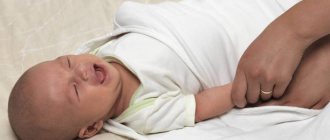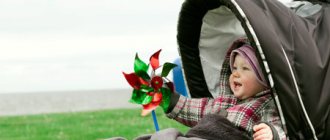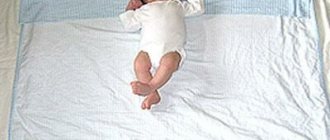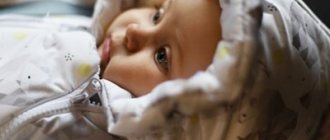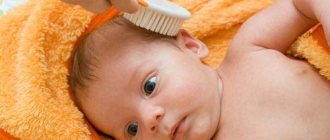02 October 2016
Averyanova Sveta
During the 9 months of pregnancy, expectant mothers imagined with delight how their life would change after the birth of the baby, how it would be filled with love and care for the dearest person.
This moment has come, the baby, buried in his mother’s breast, is sleeping peacefully, and the young mother protects his sleep and wants to protect him from all adversity. (By the way, maternal care will manifest itself not only in the first days or at 4 months, but throughout life). And the first problem she may encounter is not knowing the answer to the question of how to dress a newborn when going for a walk so that he does not freeze or overheat.
This issue should be approached thoroughly, because overheating of a baby both at 3 months and at the age of one year is fraught with a cold in the same way as hypothermia. In the pictures below you can see what to wear for children for a walk at a certain temperature.
How to dress a newborn for a walk in the spring
When a child is born in the spring, you want to quickly start walking with him in a stroller in a spring park or forest.
But still, it is recommended that the mother come to her senses after giving birth, get used to the new position, and the newborn get used to life outside the womb, and then go for a walk. This is about a month after giving birth. If the child was born at the end of April or in May, then it is already difficult to resist walking through the green squares. In this case, wait at least 20 days after giving birth.
For more information about the peculiarities of the psychology of a newborn and caring for him: how to bathe, swaddle, dress and handle, see the online course Happy Motherhood: Methods of Gentle Care>>>
Decide how to dress your newborn outside in the spring and go for a walk.
The list of clothes for a newborn for spring is something like this:
- flannel diaper (can be placed in the stroller);
- T-shirt;
- a long-sleeve bodysuit with fasteners between the legs (for convenient diaper changing);
- short sleeve bodysuit;
- slip.
And:
- The sliders are thin.
- The rompers are warm.
- Thin jacket.
- Warm sweater.
And further:
- thin hat (bonnet);
- warm hat;
- thin socks;
- warm socks;
- envelope or overalls made of padding polyester or fleece;
- terry or fleece overalls (for warm weather);
- a warm blanket.
To understand how to dress a child in the spring, first look at the thermometer, pay attention to humidity, wind strength, cloudiness, and precipitation. Here are several options for newborn clothing combinations:
- A thin slip (under which you can wear a T-shirt), a fleece slip, a thin hat, a warm one on top, a light warm jumpsuit.
If there is wind, you will need insulated overalls. This option is suitable if the thermometer shows from +1 to +5 degrees.
Just in case, take a blanket with you. If there is wind or rain, cover the newborn.
- A cotton slip, a thin cap, a warm slip on top (you can have a fleece overall), a warm hat and a light overall with insulation.
This set of clothes is suitable for air temperatures from +5 to +10. It may seem like it's already quite hot outside, but it's not. The weather in spring is deceptive. A blanket or rug will also come in handy.
- A cotton slip, a warm fleece slip, a light but thick hat and a thin overalls. This kit is suitable when the thermometer is from +10 to +15 degrees. This is the case when it is time to monitor the child so that he does not get hot and does not sweat.
- Cotton sleepsuit, fleece overalls, thin cotton hat, warm socks.
This is how you can dress a newborn for a walk in the spring if the air temperature is from +15 to +20. The weather is still deceptive, do not rush to undress your child, because at +15 it can be both sunny and cloudy. A thin blanket may still come in handy.
- A cotton bodysuit, a thin cap and thin socks can be worn on a newborn when it is +20 to +25 outside.
Still, take pants, another pair of socks and a flannel diaper with you, just in case. The wind in the spring may still be cool, then the newborn can be covered with it.
Also remember that the sun is not only beneficial for children, but can also be dangerous.
- A thin sleeveless bodysuit (or a T-shirt with panties), light socks, and always a Panama hat or a thin cap. This option is suitable for hot weather, when the outside temperature is +25 and above.
If the weather is already hot outside, walk with your newborn before 11 am or in the evening when the sun is less active.
Be sure to bring plenty of water for yourself and a light diaper to protect your baby from the sun in the stroller.
In warm weather, you can walk with your child as much as suits you. There is no standard for walking.
Keep in mind that the younger the baby, the more often he wants to breastfeed, which means take care of your clothes - let them be comfortable sweatshirts or T-shirts for feeding. You can feed your baby on a bench or even on the go if you learn how to use a sling.
If you have problems with breastfeeding, watch the online course Secrets of Breastfeeding>>>
It is more convenient to take a walk to sleep with a newborn. But as the baby grows, try to plan your walk so that the child walks while awake and sleeps at home.
Watch this video about sleeping while walking on the streets and why you should avoid it:
We dress 4-5 years old
Deciding how to dress a child at 4-5 years old is already easier. The baby already knows what things he likes and what he doesn’t like, he can tell if he is uncomfortable, cold or hot. So there are no complicated recommendations here. In the warm season, just wear things made from natural, breathable fabrics. In the cold season, adhere to the principles of layering:
- first layer (base) – underwear made from natural materials, thermal underwear or a thin T-shirt with long sleeves (if it’s cold outside);
- second layer (intermediate) - a warm woolen or fleece jacket and pants or overalls (in severe frosts, several intermediate layers can be used);
- third layer (top) – demi-season/winter overalls or set.
Also, don’t forget to select shoes, hats and accessories according to the season. It is important that you decide how to dress your child and buy things with him. There are often cases when a baby is even ready to freeze and refuses to wear a warm thing outside simply because he doesn’t like it or is uncomfortable.
More about clothes
When buying warm clothes for autumn and winter, you need to approach it wisely. Nowadays you can find anything in stores, so it’s easy for a young mother to get confused. Basic requirements for clothing for infants:
- hypoallergenic. Choose clothes made from natural materials. Things that fit close to the body can only be cotton, and warm outer clothing can be filled with down or feathers;
- safety. Avoid buttons, fasteners, zippers, and any metal accessories that could injure the child;
- convenience. Clothing should provide freedom of action and not constrain the baby;
- simplicity. Choose items with buttons, as putting them on over your head is much more difficult.
From general rules, let's move on to more specific characteristics of the main winter things.
Choosing winter clothes correctly
A cap
A hat is a very important element of a winter wardrobe. Ideally, it should cover the forehead, ears, and neck. Be sure to select a hat that is the right size, otherwise it will leak.
Pay attention to the material too. Fleece or terry cloth is best, but woolen items can also be used.
Let us remind you that you must wear a cap under a woolen hat, as wool can cause itching and irritation.
Overalls
The main criterion when choosing overalls is the lining material. A fleece overall is suitable for autumn or early spring, but in winter it will already be cold. Therefore, you should give preference to sheepskin or down filling.
There are overalls with a synthetic lining, but you need to be careful with them, since many are much warmer, and overheating is no less harmful than hypothermia.
Warm overalls - the best option for winter
Socks
Socks are needed in any case - even if the overalls cover your legs, additional insulation in this case will not be superfluous. Feet are one of the most cold-sensitive parts of the body, so they need to be doubly wrapped. Choose products made from natural materials: wool or fleece.
How to dress a newborn for discharge
Discharge from the hospital is the most important event in the life of young parents. Nowadays, on store shelves you can find ready-made kits for discharge, or you can pick up things yourself. Just a couple of decades ago, people got by with diapers and a blanket. Now babies are sent home like princes and princesses - in beautiful envelopes, with lush bows.
For checkout you need:
- diapers (often replaced with a diaper);
- socks, a pair of thin ones, a pair of warm ones;
- cap, one thin, one flannel;
- warm hat (for those born in winter);
- vest;
- blouse;
- panties;
- blankets, thin and warm (or an envelope).
All clothing should be made from natural materials, soft, without rough seams.
Wardrobe for a newborn
In fact, a small child does not need many things at once. A newborn's wardrobe is assembled gradually, from season to season and as it grows. The main thing is to adhere to general criteria when choosing clothes:
Material. All clothes, especially underwear, should be made from natural materials. Cotton is rightfully considered the best, with natural knitwear and wool taking second place. The main thing is that the material is of high quality, pleasant to the body and does not cause unpleasant sensations in the baby.
Quality of tailoring and cut
This is very important, as rough or crooked seams will put pressure and rub on the baby. Underwear for the little ones should be made with external seams
Seams familiar to an adult are relevant for outerwear. In addition, all fabric joints must be tight, and clothing must be comfortable, taking into account the anatomy of the newborn.
Color. So far, the baby’s vision is very blurry; he will develop color perception by 4-5 months. But now it is important to understand that too bright colors will irritate the baby. Therefore, it is better to choose wardrobe items in pastel shades.
Practicality. The baby doesn’t need extra ruffles and stripes; they will only put pressure and get in the way. All things should be washed well and easily ironed, because you will have to do more washing and ironing than you think. Fastenings on sweaters and overalls, first of all, should be comfortable for you - it is the mother who has to dress the child several times a day.
Safety. Buy clothes only from certified stores. Fabric is dyed in different ways; it is important to make sure that the child will not be allergic to the dye. In addition, you should not take clothes that have a lot of rhinestones and sequins that come off easily - sooner or later they will definitely end up in the little one’s mouth or nose.
In addition, when choosing a basic wardrobe, you can focus on the main categories of clothing:
- Wearable. This is what you will put on your newborn's naked body. These clothes should be of the most natural and high quality, as they come into direct contact with the baby’s skin.
- Warm. We are talking about more or less warm blouses with long sleeves and pants. It is worn over a body kit, so there is a wider choice of fabric.
- Upper. These are all kinds of overalls. Warm jackets and pants are not yet relevant - in them the baby will blow out at the junction of the floors of the jacket and the waistband of the pants. In this regard, overalls for newborns win. It is better to choose options with a lining, sewn legs and a hood, especially for the winter.
- Hats, mittens, socks. This goodness should also be oriented according to the season - from light caps to woolen hats, from thin mittens and socks, to woolen options.
- Shoes. This happiness is of no use to a newborn yet, especially if you have overalls with legs. Now the best shoes for toddlers will also be warm booties made of wool or soft suede.
We dress 10-15 year olds
It is unlikely that you will be able to dress a child at 10, much less at 15 years old. At this age, children are already becoming or have become teenagers and decide for themselves what, when and where to wear. If you buy things according to the taste and style of your son or daughter, there will be no problems with him freezing or overheating.
As you can see, the question of how to dress a child according to the weather is not so difficult if you know the basic principles of wardrobe design. It is important that he always has high-quality items made from good modern materials, especially for outerwear and shoes.
Share this article
How to dress a child for a walk
It is best to dress a child for a walk the same way a mother dresses herself, adding another extra layer of clothing. For example, in cold winter weather (-5 – -15°C) you should wear a knitted overalls and a woolen blouse over your bodysuit, and a jumpsuit on top. Then you need to put the child in a special envelope. It is preferable if it is made from natural fur, such as sheepskin. The baby should have a knitted cap and a warm cap on his head. Recently, winter helmets have appeared on sale with an inner cotton knitted layer and an outer woolen layer. Some models have insulation in the forehead and ears. Of course, in this case there is no longer any need to put anything inside.
You should not wrap your child’s face with a woolen scarf, covering his mouth and nose. This is not only not useful, but also harmful, because constantly covering the nose and mouth creates the preconditions for sudden hypothermia if this protection is suddenly not available. The mucous membranes of the mouth and nose are very richly supplied with blood, which ensures an increased temperature in the mouth and nose, which in itself prevents hypothermia. In addition, contact of the mucous membrane with cool air allows you to train protective mechanisms and strengthen the immune system.
In the off-season (spring and autumn), when dressing your child, you need to focus on the weather. If it is not very cold outside (up to -5°C), there is no wind and it is not damp, three layers of clothing are enough: a bodysuit, a jumpsuit and outerwear - a demi-season jumpsuit. In this case, the envelope may be made of thin padding polyester; You can also use a blanket instead.
At this time of year, people still put two hats on their heads - a thin one and a warm one. They can be replaced with a helmet that has a cotton top layer. If it is damp and windy in spring or autumn, then it is better to dress the child almost the same as in winter, given that dampness and wind significantly increase the risk of hypothermia even at above-zero air temperatures. In summer, when dressing a child for a walk, it should be taken into account that, being in stroller, the baby can overheat quite quickly, because... Air circulation inside the stroller is impaired. If at the same time the child is also dressed with excessive care, then overheating occurs twice as fast.
In summer, in hot weather, a child can only wear a bodysuit. As soon as the weather begins to permit, you need to open the arms and legs - this is one of the measures to prevent rickets, since vitamin D is formed under the influence of ultraviolet rays.
A small child seems so defenseless and vulnerable to us that we instinctively strive to dress him warmer and wrap him up more thoroughly. It seems to us that he must be cold, that he has cold hands or feet. In our efforts, we almost always dress the baby too warmly, doing him a disservice. Firstly, being dressed warmer than necessary, the child overheats. This is especially true for babies - the first months of life. Having overheated, the baby begins to worry and scream. Secondly, a child dressed too warmly sweats, which is known to increase the risk of catching a cold. Finally, children who are systematically dressed with excessive care constantly overheat and are more susceptible to colds or viral diseases. The fact is that in this case their thermoregulation system is not trained. The child constantly struggles with overheating, and the slightest drop in temperature is perceived as stress to which the body cannot respond adequately. Therefore, even a moderate, and even more pronounced, decrease in ambient temperature causes a sharp weakening of the immune defense, and the child becomes ill.
When are socks needed? Cute little socks and booties are often a symbol of a child's wardrobe, but they are only appropriate to use if the onesie the baby is wearing does not have feet, i.e. its lower part is trousers. There is no need to wear socks on rompers and overalls if the temperature at home is maintained at a comfortable temperature for the child - socks are additionally worn for low birth weight or premature babies.
How to dress a newborn in the fall
The weather in the autumn months is as unpredictable as in the spring, so take into account all previous recommendations.
In addition, acclimatization to lower temperatures occurs in the fall. The body is preparing for winter. In this regard, you need to add mittens, a scarf, and warm overalls to your baby’s wardrobe.
It is also important that the child’s outerwear has water-repellent properties, since rain is a common occurrence in the fall.
How to dress a newborn for a walk in the fall at +10+15
Choosing winter clothes
The main thing to remember here is to prevent overheating. Otherwise, summer is a wonderful time when you don’t need a lot of clothes and parents don’t worry much about the right set of clothes.
There are amazingly convenient tables and picture tips on the Internet that offer the right set of clothes for children for each type of weather. Here is a wonderful table for each age - the first column indicates clothes for children from 0-6 months, the second - from 6 to 12 and the third - for children from one year.
What other differences depend on age?
For infants, the absence of rough seams, buttons and elastic bands on clothes is very important. Delicate skin is very easy to injure
In addition, such a baby can walk in the cold for a strictly limited time. The baby is not yet able to warm itself well. Grown-up children actively move while walking, thereby warming themselves. In clothes that restrict movement, they will not only be uncomfortable, but also cold.
So, the most important thing: consider the child’s age and his activity on the street.
Remember, children who not only sleep but are also awake during a walk require a separate approach to clothing. When the child is awake and active, he only needs clothes appropriate for the weather, and if after that he gets tired and falls asleep, parents must cover him with a blanket or put him in an envelope.
Take everything with you. A little difficult, but health is more important!
When choosing winter clothes for a newborn, take into account the air temperature and weather conditions such as wind, sun or precipitation. For babies, you need to choose the right clothes so that they do not cause an allergic reaction to delicate skin. To do this, make sure that all materials are natural and contain as few dyes as possible.
If the first months of the baby’s life pass during the winter period, mothers make sure that there are as few bare parts of the body as possible. To do this, purchase a special overall that is worn under outerwear. It will protect the back and belly of an infant from hypothermia.
For newborns, it is not recommended to purchase clothes with large fittings, such as zippers, buttons, etc. To ensure that the baby does not experience discomfort from clothes, they are chosen with seams on the outside and soft buttons.
Babies are dressed warmly, but not bundled up
Newborns don't need a lot of things for walking in winter. All of them make up three layers of clothing: underwear, warm and outerwear, as well as socks, mittens, hats and a scarf. To understand that the child is wearing the right amount of clothes, they touch his neck before going out. If it is very hot and even wet, it means that the child is already wet, and you need to remove one layer of clothing.
Parents should remember that newborns have a very different metabolism from adults. Therefore, if parents are freezing somewhere, the child may be quite fine. Most often, there are precisely those cases when the child is not cold, but sweating.
Choosing a cap
Choosing the right baby hat is an important point, since it is the baby’s head that freezes first.
Important! Infants must wear a thin cap or cap under a warm outer cap. This is done not only to preserve heat, but also to prevent irritation.
The cap covers the head as much as possible
It is recommended to give preference to larger overalls (size 60 is just right). If a child was born at the beginning of winter, then during the winter he will grow quite quickly. If you take a jumpsuit that is smaller in size, then by spring it may already be too small. The baby will wear overalls size 60 all winter and early spring.
In this case, the size is determined by the height of the child. Many modern manufacturers of children's clothing produce products indicating sizes 0-1, 3-5 and the like. This refers to the child’s age in months – from birth to 3 months. If only one number is indicated, then we are talking about years.
The main attention is paid to the type and thickness of insulation. Filling happens:
- fleece;
- feathers or down;
- sheepskin or camel hair;
- synthetic product (sintepon, etc.).
For the winter option, it is recommended to take a wool lining, since it is considered natural and warm. Fleece is a good option for fall or winter.
At the same time, it is important for parents to understand that even the warmest type of overalls filling can only retain heat for a limited amount of time. If mothers plan to walk for more than 30 minutes, the child will gradually freeze
Don't forget about socks. For a winter walk, babies wear two pairs of socks: thin and woolen. A second layer of socks is required, even if the overalls are warm enough. Wool materials are best suited for warm socks.
How to dress a newborn at home
If the house is cool enough - up to 20 degrees, it is recommended to dress the newborn in two layers of clothing. For example, we choose a warm suit, and under it we wear a light T-shirt and panties-diapers. If the temperature in the room is above 23 degrees Celsius, a cotton overall or a light T-shirt with shorts will be enough. In any case, during the first months, do not forget about socks and a hat; your legs and head should be warm, especially after swimming.
Drafts are absolutely harmful for babies. Ventilate the room when the child is away.
Comfortable things for a child in rainy and windy weather
If there is rain and wind outside the window, then an umbrella will definitely not save anyone.
This is a beauty: drops of cold rain fly in the wind right into your face, easily bypassing the unfortunate broken umbrella, which is still trying to fly away somewhere and drag the exhausted owner along with it.
In rainy weather, only the lucky owners of raincoats and rubber boots remain at least partially dry.
You can protect your face with the visor of a baseball cap.
Next year you will wear the same boots in the summer with a thin toe.
Just an option for St. Petersburg slush, which no normal shoes can withstand!
And kids feel most comfortable in such weather.
They sit in a stroller, covered with a plastic cape, which reliably protects them from rain and sleet in windy weather, and doesn’t worry about anything.
And again, rubber pants will help you, I wrote about them a little higher!
What to take with you on a walk
Above-zero temperatures in autumn can quickly drop to zero and vice versa.
Moms need to stock up on this case with the following list of things for walking:
- Blanket, thin blanket. They can be used to cover the child or make a protective curtain from the wind in the stroller.
- Raincoat, umbrella for mom.
- Waterproof stroller cover.
- Wet wipes, handkerchief.
- Water.
- A diaper or towel to sit with your baby outside for breastfeeding.
- On cold days - a stroller; in warm weather - a sling scarf, for babies from 6 months - hipsit.
- At home and on the street during long walks - children's sunscreen, on frosty days - to protect the face and hands from the cold.
More on the topic “How to dress a one-month-old baby”:
Tell me about your loungewear
And tell me how your children are dressed at home now. a slip without feet (I don’t know what it’s called correctly) + socks if your paws are cold.
How to dress a child correctly?! Somehow I forgot everything :)
But do you need bodysuits? Or should I wear all my slippers and all my clothes on my naked body? Tell us how you dress your babies up to 5-6 months.
How should I dress to the clinic?
Girls, hello, we are almost 1 month old, we have a trip to the clinic, and the question has arisen - how to dress. We are in Moscow (it’s still warm at +8). We walked outside in 2 layers of clothing and a fur-lined envelope, because... When dressing, she often wakes up, so as not to wake up - she began to swaddle her clothes in a fleece blanket, and today we walked around in a diaper and a transformable blanket with fur, the child refused.
How to dress a 6 year old child outside
At preschool or primary school age, the child already strives for independence with all his might, including when choosing clothes. Theoretically, parents may know how to dress a 6-year-old child outside in winter, but he may actively resist and insist on what he likes. To avoid such surprises, always choose clothes together with your baby so that he wears them with pleasure.
It is important to continue to follow the three-layer principle, increasing their density depending on the temperature and wind outside the window. In winter, you can add an extra layer of clothing, but make sure that the child does not overheat. Doctors warn that overheating during a walk is much more dangerous than hypothermia; it is this that provokes colds. For example, if you don’t know how to dress a child outside at a temperature of 15°, analyze your clothes and add another light layer for your beloved child.
It is important to understand that all tables and rules presented are just recommendations. Much depends on the child himself and the degree of his activity. It is necessary to take into account not only the air temperature, but also the characteristics of the native climate. Taking into account the advice of pediatricians and your own feelings, you can easily choose the right clothes for walking so that your baby is always comfortable.
Dressing a baby for a walk in winter
Several decades ago, doctors insisted that a child should be dressed one layer warmer than the parents were dressed when walking outside. But today this rule does not apply in most cases. The fact is that children's clothing manufacturers present models of overalls with lightweight, hypoallergenic insulation, which retain heat remarkably well and the baby will definitely not freeze. Therefore, pediatricians recommend dressing babies according to the weather and depending on temperature, wind strength and other factors.
Winter overalls should be light and not restrict the baby’s movements.
List of things for a baby born in winter
- Baby vests, long sleeve bodysuits or slips made of cotton fabric.
- Romper with a high rise so that the elastic does not rub the wound from the umbilical cord.
- Tight cuts or overalls made of cotton and fleece.
- Socks.
- Lightweight hat or cap made of natural cotton fabric.
- Warm knitted hat with ear ties.
- Warm overalls or an envelope lined with mittens to protect the baby's hands from the cold.
Features at different temperatures
In winter, the temperature outside the window can be different, so you need to insulate the baby in accordance with the mark on the thermometer. But don’t forget about humidity and windiness, because even a not too low temperature with a strong wind can be colder than just severe frost.
For winter walks at temperatures from 0 to -10 degrees, the baby’s clothes look like this:
- man, long-sleeved bodysuit, or romper and vest. Parents themselves choose a clothing model depending on the personal preferences and comfort of the child;
- thick fleece or knitted overalls;
- terry socks;
- You need to put a thin cap on your head;
- a warm knitted hat, always with ties, so that the baby’s ears are well covered;
- warm winter overalls or envelope.
Clothing should be selected from natural fabrics that are breathable and retain heat.
We dress the baby for a walk at a temperature of -5 -10 degrees - video
At temperatures below -10 degrees, the algorithm for dressing a baby remains the same, but you should take a warm blanket or blanket outside to cover the baby well in the stroller and protect it from the cold. Terry socks can be replaced with woolen ones, and you should definitely put a hood on your head.
A blanket or blanket should be added to the set of clothes, which should always be in the stroller in winter, just in case.
Weather - 15 degrees: how to dress a child for a walk - video
If the weather is pleasant in winter with temperatures about and above degrees, then we dress the baby a little lighter:
- We put on a cotton slip or a long-sleeved bodysuit over the diaper;
- thick fleece overalls or knitted suit;
- You need to put a thin cap and a demi-season hat on the baby’s head;
- warm demi-season overalls or winter outerwear, but unfasten the sheep wool lining, if any.
To avoid overheating your baby, you can leave a warm snowsuit on, but do not put on a second layer of clothing.
Walking with your baby at temperatures above 0 degrees: how to dress - video
Walking correctly: Dr. Komarovsky’s advice for newborns and one-month-old babies
The famous pediatrician supports the opinion of all doctors in the world that walking with newborn children in winter is a must. After 10–14 days from birth, you can take the baby outside for no more than 15–20 minutes, if the temperature is not lower than -15 degrees. After a week, you can increase the walking regimen and go out with the baby twice a day for half an hour.
Do not cover your baby's mouth and nose with a scarf. This will not only lead to the baby getting cold, because the face sweats under the scarf, but it can also cause the child to catch a cold. The main rule is that the baby needs to be dressed according to the weather, but after a walk, carefully examine the baby: if he is sweating and all red, next time you need to put one less layer of clothing on him.
How to dress a newborn in summer
The most pleasant walks happen, of course, in the summer. It’s warm, sunny, you can walk for literally hours. But you should not go outside with your baby if the air temperature is above 30 degrees.
You don’t need to think long about what to wear for your newborn when going outside in the summer. The baby does not need a lot of clothing: a light suit or sandbox made of cotton fabric is enough. A hat remains an indispensable item of clothing. It will protect the baby's head from the sun's rays.
It is allowed to leave a child without clothes while sleeping or walking. Cover your baby with a light diaper.
During hot months, it is especially important to avoid drafts. You should not go into stores with working air conditioners with your baby; even the smallest draft is dangerous for children’s health.
How to dress a child under one year old
How to dress a baby
Let's start with the tiniest things
The importance of maintaining temperature conditions for them is one of the primary tasks
It all usually starts in the maternity hospital: what should the little one wear when she is discharged? Most often, the nurse takes everything into her own hands, sweeping half of the donated children’s clothes aside, and the young father is given a cute little bag of vests and a blanket.
Only at home the mother sees that not everything she prepared was on the baby. This opens up an inevitable topic for all young parents - “How to dress a child correctly?” To avoid the same mistakes, use these simple tips:
- -10...-6°C: (it is assumed that at temperatures below this, we do not go for a walk): warm vest, warm overalls-slip underneath, booties, demi-season cap, winter overalls, hat;
- -5...-1°С: we leave everything the same, removing the booties and warm vest;
- 0...4°C: overalls-slip, hat, winter overalls, scarf, if you haven’t got a slip yet - warm rompers with a vest;
- 5...9°C: replace the warm slip with a light (non-insulated) winter overall, the same demi-season hat under the hood;
- 10…13°C: warm jumpsuit/warm romper and vest, demi-season hood, demi-season hat;
- 14...16°C: the same scheme as at 10-13°C, the demi-season overalls can be either baloney or made of faux fur (nowadays there are a lot of them, especially imitations of animals);
- 17…18°C: a warm slip-on overall and a light hat will be enough;
- 19…20°C: light jumpsuit + panama hat (in sunny weather);
- 21…°C: bodysuit with short sleeves and sun hat. In extreme heat, we only walk in the shade and not for long; we wear the same bodysuit with short sleeves.
How to dress a 6-12 month old baby
We have already grown up a little, we have learned to sit, we probably sit in the stroller more and more and look around. The baby's walking wardrobe also changes in some way.
- -10…-6°С: slip overalls (warm), booties, warm vest or jacket, winter overalls, scarf, demi-season hooded hat;
- -5…-1°С: leave everything the same, removing the warm blouse/vest and booties;
- 0…4°C: you can repeat the set of clothes for the previous temperature value;
- 5…9°C: replace the warm slip with a light winter overall, hat and scarf;
- 10…13°C: this temperature mark allows you to replace the winter overalls with a demi-season one, but return the sleepsuit to a warm one, the same demi-season hat;
- 14…16°С: light sleepsuit, demi-season overalls and hat;
- 17…18°C: warm bodysuit with long sleeves, velor (or flannelette) pants, light hat;
- 19…20°C: light bodysuit with long sleeves, light pants, sun hat;
- 21...°C: bodysuit with short sleeves, panama hats, if socks - then light ones, but you can do without them.
When walking in hot weather, always try to have a drink for your baby in a special thermos container. For a hot evening walk, just in case, you can take a light blouse or a light blanket if it gets colder in the evening. Take precautions against mosquitoes.
Dress for 2-3 years old
It’s easier to understand how to dress a 2-3 year old child. At this age, you can already ask him how he feels, if he is cold. Sample recommendations from the tables look like this:
- +21°C and above
. Thin cotton clothing of your choice and sandals. If you go out for a walk in the scorching sun, make sure that your child's back and shoulders are covered. Don't forget about your headdress. - +18°С…+20°С
. The same. - +15°С…+18°С
. In cloudy weather, add a warm sweater or thin jacket without insulation to the set. - +10°С…+15°С
. Add warm pants and a jacket. It’s also time to put on a demi-season jacket with thin insulation, replace sandals with boots and wear socks under them. On the head - a knitted hat. You can wear a thin scarf. - +5°С…+10°С
. In windy weather, we also wear warm tights under our pants, and on top - a demi-season overalls or jacket; you can already put on gloves. In sunny weather, especially if the child is active, you can do without warm tights and gloves. - 0°C…+5°
C. We change the demi-season overalls or set for winter insulated ones. We put on winter boots, mittens and a hat. - -5°С…0°С
. The same. Don't forget about a warm jacket and tights. - -10°С…-5°С
. The same. - -20°С…-10°С
. Add additional lining to the overalls or set, if any.
Be sure to believe the baby’s words that he is cold or hot. It's better to go home to cool down or warm up, and then go out for a walk again.
Clothing options for winter discharge
In order for the discharge to remain in your memory as one of the most pleasant memories, you need to think through and choose the clothing option for your baby in advance.
Elegant blanket – envelope with lace corner and bow
This is perhaps the most common type of clothing for releasing a baby from the hospital. A true classic - a small package in an envelope of a certain color (blue, pink) with ruffles and a large bow, arousing admiration among newly-made relatives. Pros: the appearance corresponds to a celebration, elegant, festive. Cons: the envelope is not for daily use; easily soiled; lace quickly wrinkles and loses its appearance; The size is only suitable for a newborn baby and will be small in a month.
Insulated overalls - transformer
A very practical choice for checking out, but not the most elegant. Overalls for newborns have the shape of a bag, but as they grow, they transform into pants. It is easy to care for, it will survive multiple washes and maintain its appearance. This thing will last quite a long time. If after discharge there are December, January and February ahead, feel free to choose this option.
Pros: maintains optimal heat in winter; waterproof material; convenient for further use. Disadvantages: it does not look solemn when discharged.
Envelope on sheepskin
Such an item for a children's wardrobe can be purchased once for discharge, and it will last for the first two to three years. This thing will not let you freeze even in severe frost, but the main advantage of the envelope is its versatility. It can be used for its intended purpose during the baby’s first winter; the envelope then turns into a stroller cover for the legs, and can also be taken as a bedding for a sleigh. Have you been looking for an answer to the question of how to choose an envelope for a winter discharge so that it is warm, practical and long-lasting? This envelope is the best option.
Pros: natural insulation; withstands frequent washing; durable; waterproof. Cons: expensive.
Envelope on padding polyester/holofiber
Beautiful colors, warm, soft and comfortable option - this is an envelope with various insulation. Often it can be transformed into a blanket or even a changing mat, which can be useful for the mother in the clinic or when changing clothes outside the home. Such an envelope can be found for a festive occasion with embroidery or appliqué. The product with a zipper will help you quickly dress your child when going out. Thanks to the waterproof properties of the outer fabric, it is practical and can be used in any bad weather.
Pros: windproof; waterproof; warm; acceptable price category; some models can be transformed. Cons: when washed, the insulation may become loose and the product will lose its shape.
